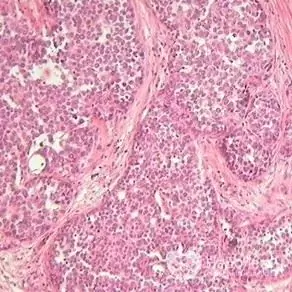- Author Rachel Wainwright [email protected].
- Public 2023-12-15 07:39.
- Last modified 2025-11-02 20:14.
Carcinoid

A carcinoid is a family of neuroendocrine neoplasms composed of cells from a diffuse endocrine system. Such cells are found in all organs and tissues, but their main accumulations are found in the gastrointestinal tract, bronchi, and urinary tract. A feature of the diffuse endocrine system is the ability to produce a number of biologically active compounds (hormones). Although the incidence has been steadily increasing in recent years, carcinoid remains a fairly rare pathology. Carcinoids vary according to embryonic origin, secretory profile, and grade of malignancy. By origin, carcinoids are divided into tumors from cells of the anterior, middle and posterior intestines. The former include carcinoids of the respiratory tract, pancreas, the initial section of the duodenum and stomach. To the second - intestinal carcinoids from the posterior part of the duodenum to the appendix, and to the third - neoplasms from the surrounding stroma and vessels. The malignancy potential of carcinoids varies widely from benign neoplasm to high grade.
Carcinoids are capable of producing biologically active compounds, including prostaglandins, kinins, serotonin, and kallikrein. The more active substances the tumor produces, the more pronounced the clinical picture of the disease.
Carcinoid syndrome is a typical manifestation of the disease. The following symptoms are characteristic: hot flashes, cramping abdominal pains, diarrhea, damage to the valvular apparatus of the heart, shortness of breath, skin cyanosis, telangiectasia. In severe cases, a carcinoid crisis may develop. This is a life-threatening condition in which blood circulation, respiration, and the functions of the nervous system are impaired. The clinical picture depends on the location of the tumor.
Lung carcinoid
Lung carcinoids are represented by typical and atypical tumors, large cell neuroendocrine cancer and small cell lung cancer. A typical tumor has a low grade of malignancy, atypical - a moderate grade. Large cell neuroendocrine cancer and small cell lung cancer are diseases with a high potential for malignancy. Mostly men over 60 years old are ill. In most cases, small cell lung cancer develops. The prognosis is extremely unfavorable. The five-year patient survival rate is less than 8%. The vast majority of lung carcinoids are caused by smoking.
Carcinoid of the stomach

Stomach carcinoids are of three types. Type A is combined with chronic atrophic gastritis, type B - with Zollinger-Ellison syndrome, type C occurs independently. In type A carcinoid, the secretion of hydrochloric acid in the stomach decreases, the level of gastrin increases, and anemia is also often detected. Gastric carcinoids of this type are often multiple, their size does not exceed 1 cm. The age of patients is usually over 60 years. The course of the disease is considered favorable: distant metastases occur in 3-5% of cases, mortality is minimal, and there are practically no clinical manifestations. Type B carcinoid occurs most often as part of Vermeer's syndrome when there are other tumors of the endocrine glands. Carcinoid syndrome is not formed, the prognosis is quite favorable. Type C carcinoids are tumors larger than 1 cm in diameter. These neoplasms metastasize early, characterized by a high mortality rate of patients.
Carcinoid treatment
In the treatment of carcinoid, radical methods are preferred. Even in the presence of distant metastases, surgery should be considered. The technique of intervention depends on the location of the tumor and its origin. Even when the complete removal of the neoplasm and its metastases is impossible, sometimes a surgical method is used to eliminate the symptoms of the disease. Conservative drug treatment includes primarily somatostatin analogs and interferons. These drugs reduce the secretion of hormones, help stop the growth of the neoplasm and its metastases. Chemotherapeutic methods are also used, including treatment with temsirolimus, temozolomide. New approaches to the treatment of carcinoids are currently being developed. Directional drugs (targeted) are being created. These include, for example,inhibitors of angiogenesis, stopping the growth of tumor vessels.
YouTube video related to the article:
The information is generalized and provided for informational purposes only. At the first sign of illness, see your doctor. Self-medication is hazardous to health!






